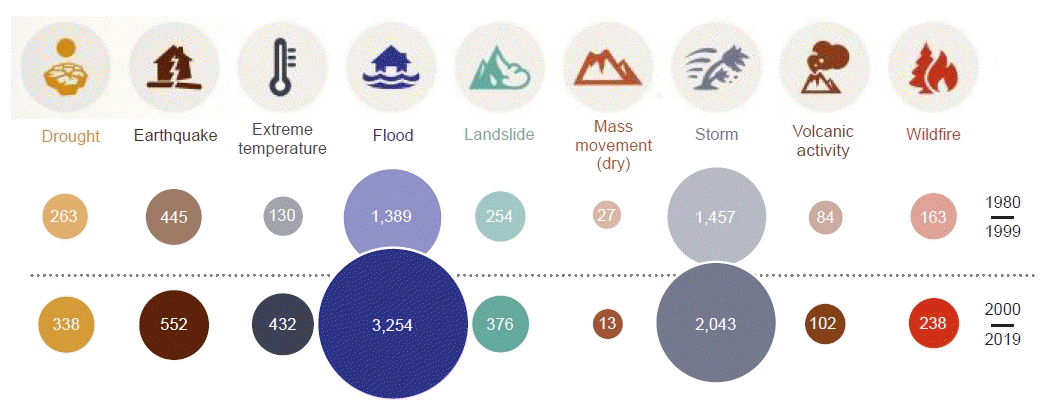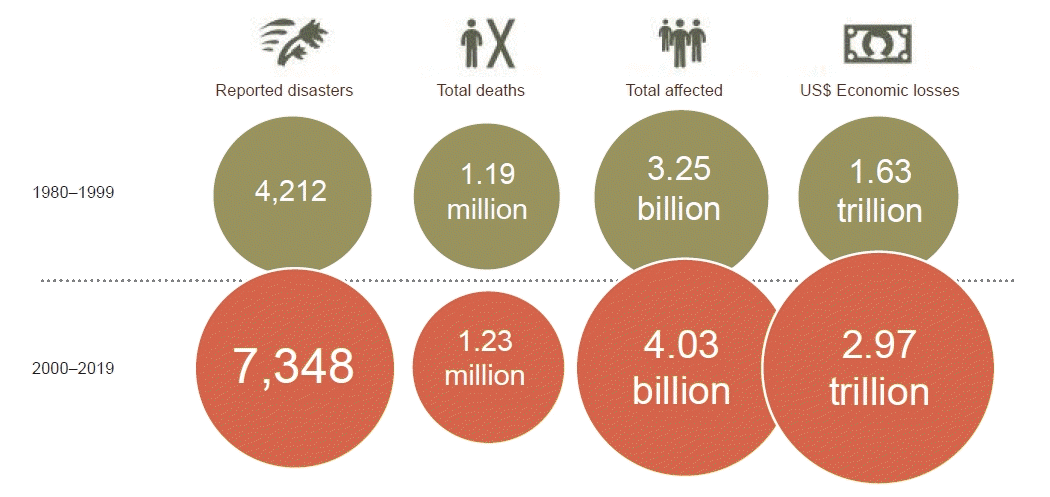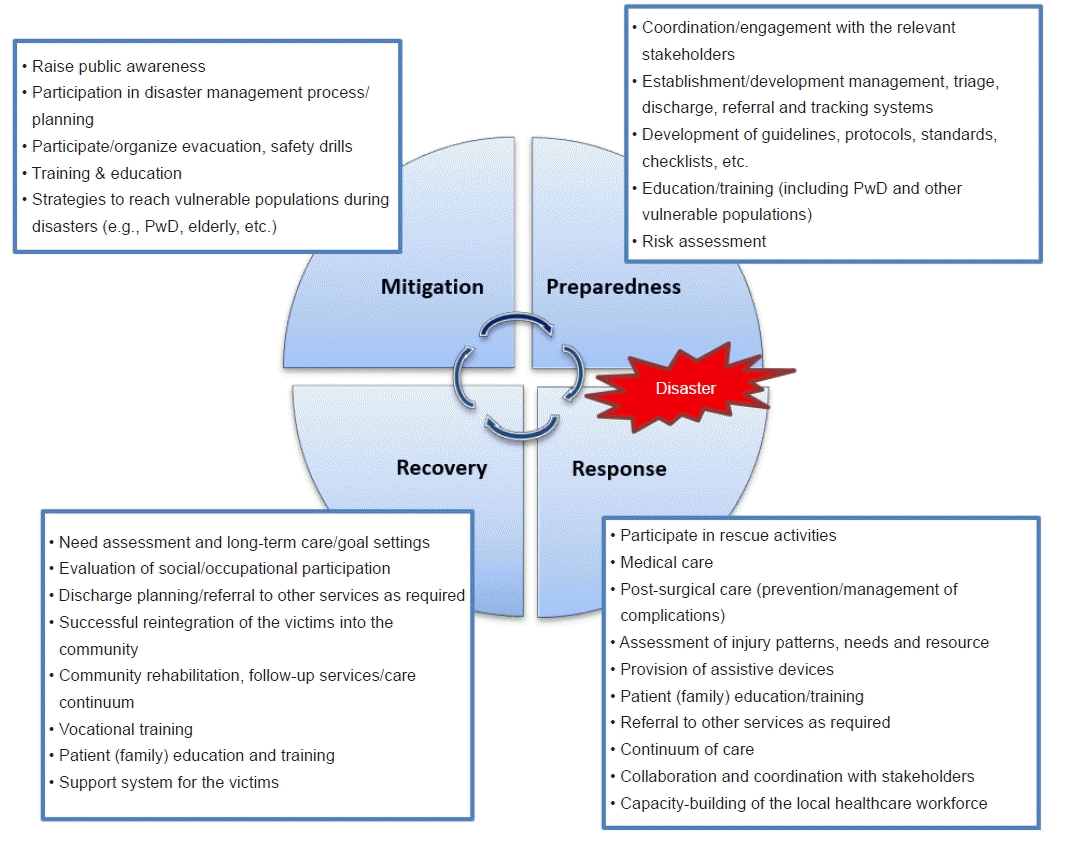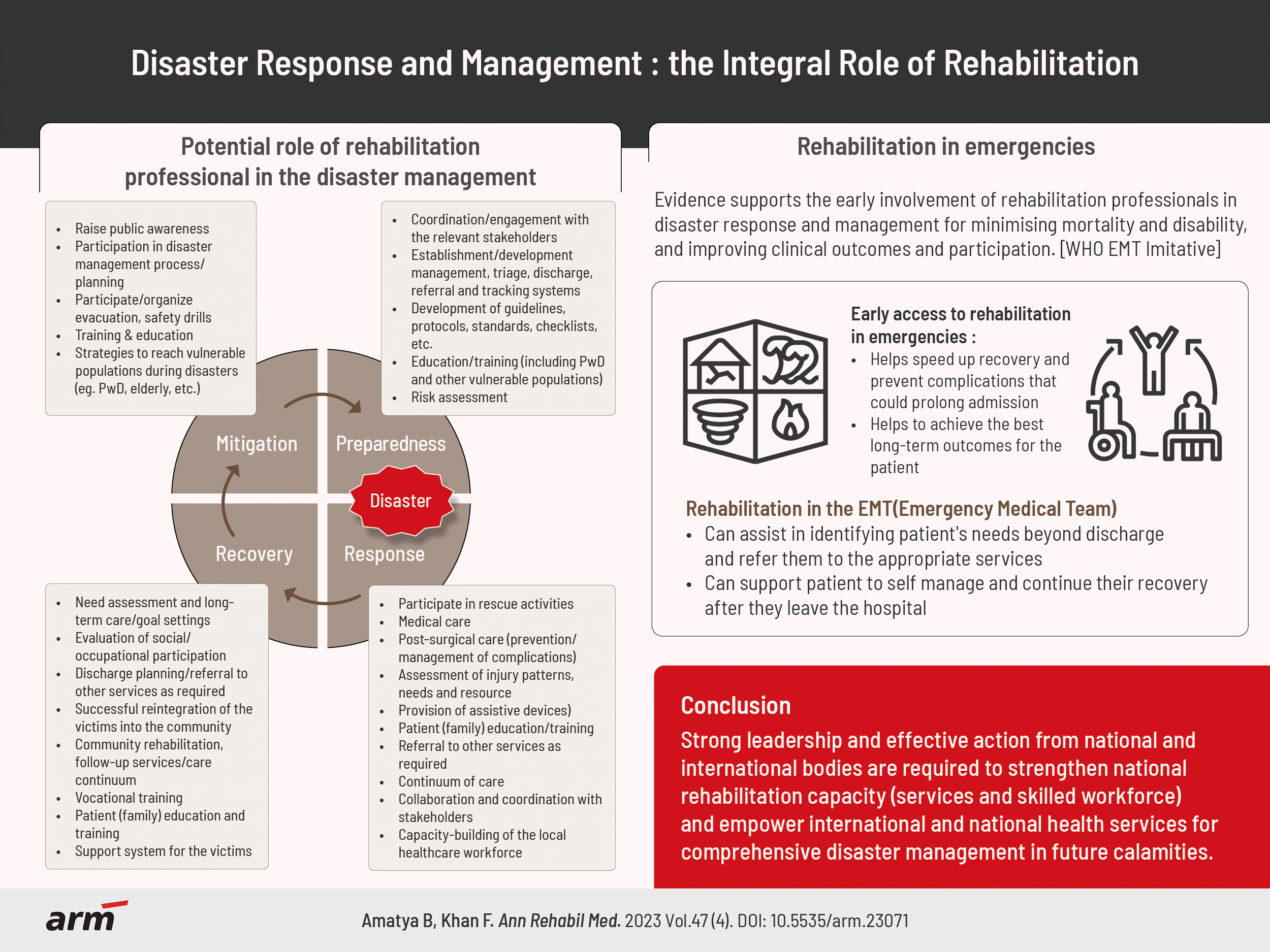Abstract
ACKNOWLEDGMENTS
REFERENCES
Fig. 1.

Fig. 2.

Fig. 3.

Fig. 4.

Fig. 5.

Fig. 6.

Table 1.
Adapted from Below et al. Centre for Research on the Epidemiology of Disasters (CRED); Munich Reinsurance Company [3].
Table 2.
| References | Study type | Interventions | Key findings | Conclusion |
|---|---|---|---|---|
| Hospital-based rehabilitation program | ||||
| Xiao et al. 2011 [40], China | Case series | Institution-based rehabilitation interventions delivered by PT | •Functional recovery was positively associated with rehabilitation intervention (OR, 5.3; 95% CI, 2.38–11.67), but negatively correlated with immobilization duration (OR, 0.87; 95% CI, 0.798–0.947), age (OR [per 10 yr increase], 0.54; 95% CI, 0.418–0.707) & depressive symptomatology (OR, 0.21; 95% CI, 0.063–0.716) | Rehabilitation was associated with functional recovery of post-earthquake survivors with fractures |
| Disaster: 2008 Sichuan earthquake | N=174 survivors with tibial shaft fractures | |||
| Zhang et al. 2012 [42], China | Cross-sectional quasi-experimental study | Institutional-based rehabilitation (details not provided) | •Significant improvement in ADLs and life satisfaction (p<0.05) | Rehabilitation (early and late) significantly improved functional outcomes, HRQoL, and life satisfaction in earthquake fracture victims |
| Disaster: 2008 Sichuan earthquake | N=390 survivors with fractures | •HRQoL improved higher in early intervention subjects compared with controls (p=0.008) | ||
| •Good performance of ADL (p<0.001) and widowed marital status (p=0.032) predicted high HRQoL, while pain was associated with worse outcomes (p<0.001) | ||||
| •Rehabilitation therapy, remunerative employment & female gender were predictors of improved life satisfaction | ||||
| Hu et al. 2012 [35], China | Prospective cohort study | Institution-based rehabilitation therapy (details not provided) | •Significant improvement in functional status (ADLs, mobility, walking) | Significant improvements in: functional status, QoL, general health, satisfaction with social relationships & some areas of community integration (physical independence, mobility) |
| Disaster: 2008 Sichuan earthquake | N=26 (SCI survivors) | •Decrease in pain and depressive symptoms | ||
| •Significant improvement in QoL in the community (p=0.011), self-ratings of QoL (p<0.001), general health (p<0.001), and satisfaction with social relationships (p=0.017) | ||||
| •Improvement in physical health and psychological health improved (not statistically significant) | ||||
| Li et al. 2012 [32], China | Prospective cohort study | Individualized rehabilitation program provided by MD rehabilitation team (physician, allied health therapists (PT, OT, traditional modalities), nurses, volunteers & other medical specialists) | •Thirty-five percent patients achieved moderate ADLs independence and 90.2% regained self-care ability | Significantly improved functional rehabilitation outcomes with organized programs |
| Disaster: 2008 Sichuan earthquake | N=51 (SCI survivors) | •Rehabilitation program was the strongest predictor of a significant increase in functional scores | ||
| •Earlier rescue and rehabilitation were significant positive predictors of rehabilitation effectiveness | ||||
| Ni et al. 2013 [39], China | Retrospective cohort study | Institution-based comprehensive rehabilitation program (therapeutic interventions, training/education, and vocational and social rehabilitation (details not provided) | •Significant improvement in physical dysfunction (p<0.001) | Physical dysfunction and PTSD were significantly reduced by rehabilitation intervention |
| Disaster: 2008 Sichuan earthquake | N=450 survivors with fractures | •Significant improvement in PTSD symptoms (p<0.05) | ||
| •Females, average or above family income, having witnessed death and fearfulness were risk factors for PTSD symptoms, 50 mo after the earthquake | ||||
| Li et al. 2015 [37], China | Prospective cohort study | Institution-based rehabilitation to prevent joint contracture, desensitization, shaping of the residual limbs, joint mobilization, muscle strength training, PT, OT & psychotherapy | •Significant improvement in physical functioning (p=0.016) and decrease in pain scores (p<0.001) | Significant improvement in functioning and pain over time, however, no change in QoL & life satisfaction |
| Disaster: 2008 Sichuan earthquake | N=72 amputees | •No significant changes in QoL and life satisfaction subscales | ||
| •Higher rates of literacy associated with better physical and mental health status | ||||
| •Higher age associated with decreased satisfaction with leisure activities & relationships | ||||
| Wu et al 2019 [49], Taiwan | Prospective observational study | LMC (virtual reality) video games 20 min after 40 min traditional OT | •Significant improvements in hand function in the LMC group (p<0.05) compared to control group | Leap motion training could help patients with hand burns to increase finger ROM, decrease scar thickness, and improve hand function |
| Disaster: 2015 Dust explosion disaster, Formosa Fun Coast | N=16 hand burn victims; 8 participants in both groups | Control group: traditional OT for 60 min | •In LMC-trained hand, thumb IP joint ROM & pinch strength increased, whereas the scar thickness over first dorsal interossei muscle decreased (p<0.05) | |
| 2 day/wk for 4 mo | ||||
| Mixed (hospital-and community –based) rehabilitation model | ||||
| Zhang et al. 2013 [43], China | Longitudinal quasi-experimental study (3-arm); N=510 | NHV rehabilitation program - institutional-based rehabilitation followed by CBR comprised of: NGOs (N), local health departments (H), professional volunteers (V) | •Significant improvement in physical functioning (Barthel Index) in the both NHV–E and NHV–L intervention groups but not in the control group (11.14 points; 95% CI, 9.0–13.3) | Significantly improved physical functioning of earthquake survivors |
| Disaster: 2008 Sichuan earthquake | Early intervention group (NHV–E): 298; late intervention group (NHV–L): 101; control group: 111 | •Significant effects on spontaneous recovery (5.03 points; 95% CI, 1.73–8.34) | ||
| •Effect of NHV-E (11.3 points; 95% CI, 9.0–13.7) was marginally greater than that of NHV-L (10.7 points; 95% CI, 7.9–13.6) | ||||
| Li et al. 2019 [38], China | Cross-sectional study | MD rehabilitation program – StandTall (exercise and education) | •Subjects with bilateral through-knee or transtibial amputations had less activity restriction (p<0.01) & higher mobility (p=0.03) | MD rehabilitation program (StandTall) was associated with positive functional and psychological outcomes in disaster survivors with complex needs (bilateral knee amputees) |
| Disaster: 2008 Sichuan earthquake | N=17 bilateral limb amputees | •Subjects using prostheses >50% of waking time had better general adjustment (p=0.02) & less functional restriction (p=0.01) | ||
| •StandTall program were associated with higher mobility (p=0.06) & mental quality of life (p=0.09) | ||||
| Psychological programs | ||||
| Becker 2009 [44], India | Prospective cohort study | Community-based psychological program (group sessions) | •Significant improvement in psychosocial symptoms IES scores: total (p<0.001) & avoidance (p<0.001), intrusion (p<0.001), hypervigilance (p<0.001) | Effective in reducing emotional distress for women tsunami survivors |
| Disaster: 2004 tsunami | N=200 | |||
| Berger and Gelkopf 2009 [45], Sri Lanka | Quasi-RCT with wait-list controls | School-based mental health program | •Significant improvement in PTSD severity (p<0.001), functional problems (p<0.001), somatic complaints (p<0.001), depression (p<0.001), and hope (p≤0.001) scores | Helpful in mitigating post-disaster-related symptoms in children, and those with more severe symptoms benefited most |
| Disaster: 2004 tsunami | N=166 elementary school students | |||
| Zang et al. 2013 [41], China | RCT with wait-list controls | NET | •Significant reductions in PTSD symptoms: avoidance, intrusion & hyper-arousal subscales (p<0.001 for all); anxiety & depression (p<0.001), general mental stress (p<0.0001) & increased posttraumatic growth (p<0.001) | Significant positive effect on psychological symptoms & general mental health |
| Disaster: 2008 Sichuan earthquake | N=22 | |||
| Jiang et al. 2014 [36], China | RCT with usual care controls | 12 weekly sessions of IPT, 1 h for 12 wk | •At 3 mo, compared to control group significant reduction in the IPT group: PTSD (3.4% vs. 51.9%), major depressive diagnoses (3.4% vs. 30.1%) | IPT is a promising treatment for reducing PTSD & depression in populations surviving natural disasters |
| Disaster: 2008 Sichuan earthquake | N=49, intervention group: 27 | •Treatment gains were maintained at 6 mo for the IPT group | ||
| Social activity and community programs | ||||
| Huang and Wong 2013 [47], China | Before and after qualitative study | Recreational activity groups | •Participants’ social networks broadened and strengthened | Effective in alleviating disaster survivors’ feelings of distress & depression, & improves their psychosocial well-being and recovery |
| Disaster: 2008 Wenchuan earthquake | N=24 | •Participant recognised the importance of mutual understanding and developed a sense of cooperation | ||
| •After participating in group activities, most women felt life was more meaningful or happy | ||||
| •Participants’ health improved | ||||
| Tsuji et al. 2017 [17], Japan | Prospective observational study | Group exercise and regular walking | At 3 yr post-disaster: | Participation in group exercises or regular walking may mitigate the worsening of depressive symptoms |
| Disaster: Great East Japan Earthquake/tsunami 2011 | N=3,567 older survivors | •Depressive symptoms slightly improved, mean change in GDS score increased by 0.1 point (95% CI, -0.003 to 0.207) | ||
| •Frequency of group exercise participation & daily walking time increased by 1.9 day/yr & 1.3 min/day, respectively | ||||
| •After adjusting for all covariates, including personal experiences of disaster, increases in the frequency of group exercise participation (p=0.003) & daily walking time (p=0.054) were associated with lower GDS scores | ||||
| Akiyama et al. 2018 [46], Philippines | Quasi-experimental trial, N=293 students from 3 schools, including 1 intervention school (n=51 students) | MAC: a coaching education program on sports activities | •MAC intervention showed a significant change in self-esteem, with the mean score increasing from 20.2 to 21.1 (p=0.02) | Results showed the feasibility and a positive effect of sports activity with the MAC post-disaster |
| Disaster: 2013 Typhoon Haiyan | •Neither school in the control group showed a significant change | |||
| Kuroda et al. 2018 [48], Japan | Prospective cohort study | Group exercises (1 h twice a month for 1 yr) | •4-yr post-disaster incident functional disability reported in 24.2% (280 cases): 196 (70%) mild, 84 (30%) severe | Pre-disaster BCL domains were useful to identify individuals at risk of functional disability |
| Disaster: Great East Japan Earthquake/tsunami 2011 | N=115: exercise class group: 159 usual care control group: 1,000 | •Participants who scored negative compared to those who scored positive in BCL: for the “Physical function” domain HR=2.04 (95% CI, 1.54–2.69) for incident functional disability; for “Cognitive function” HR=1.37 (95% CI, 1.06–1.77); for “Depression” HR=1.60 (95% CI, 1.24–2.08) | Group exercise therapy showed a significant reduction in incident functional disability | |
| •Both low- and high-participation exercise groups had a significantly lower rate of incident functional disability compared to non-participating group (HR=0.27, 95%CI, 0.16–0.46; HR=0.30, 95%CI, 0.12–0.74, respectively) | ||||
| Fahmida et al. 2022 [50], Indonesia | Quasi-experimental trial (N=480 children <5 years old) | Community-based comprehensive nutrition rehabilitation, based on the holistic integrated early child development concept | •Significant reduction in depression in mothers in the intervention group (61% vs. 43% post-intervention, p<0.001); no change in control group (43% vs. 40%, p=0.272) | Nutrition rehabilitation intervention has a positive effect on the growth & development of children |
| Disaster: 2018 East Lombok earthquake | Intervention group (n=240); usual service control group (n=240) | •Child morbidity (cough) lower and dietary diversity (+1) in 6–23-month-old children, & weight-for-age Z-score (+0.26) & social-emotional score (+10 points) in 24-month-old children were higher in intervention group | ||
N, total number; PT, physiotherapists; OR, odd ratio; 95% CI, 95% confidence interval; ADL, activity of daily living; HRQoL, health-related quality of life; SCI, spinal cord injury; QoL, quality of life; MD, multidisciplinary; OT, occupational therapists; PTSD, post-traumatic stress disorder; LMC, leap motion control; IP, interphalangeal; ROM, range of motion; CBR, community-based rehabilitation; NGO, nongovernmental organization; IES, Impact of Event Scale; RCT, randomized controlled trial; NET, narrative exposure therapy; IPT, interpersonal psychotherapy; GDS, Geriatric Depression Scale; MAC, Mastery Approach to Coaching; BCL, Basic Checklist; HR, hazard ratio.
Table 3.
| Initiative/strategy | Key features | Comments |
|---|---|---|
| Hyogo Framework for Action 2005–2015: Building the Resilience of Nations and Communities to Disasters, UNDRR 2005 [56] | •Comprehensive global blueprint for disaster risk reduction adopted by 168 UN member states at the World Conference on Disaster Risk Reduction in Kobe, Japan, in 2005 | •Voluntary and non-binding |
| •Key 5 priorities for action | •Embraced by central and local governments, the private sector and civil society groups | |
| - Ensure that disaster risk reduction is a national and a local priority with a strong institutional basis for implementation | •In 2015, Hyogo Framework focal points in 191 countries and 85 platforms for disaster risk reduction, and 141 countries have carried out at least one review of their efforts to implement this Framework for action | |
| -Identify, assess and monitor disaster risks and enhance early warning | ||
| -Use knowledge, innovation and education to build a culture of safety and resilience at all levels | ||
| -Reduce the underlying risk factors | ||
| -Strengthen disaster preparedness for effective response at all levels | ||
| GFDRR, 2006 [57] | •Key initiative to assist developing countries, reduce their vulnerability to natural hazards, with a global partnership of over 45 countries and international organisations | •Include rehabilitation and reconstruction, aligns with the SFDRR priorities and disaster-risk management activities |
| •Conducts post-disaster needs assessments and support in recovery and reconstruction, to reduce costs | •No details of programs focused on building capacity in rehabilitation medicine | |
| •Implements programs in partnership with national, regional, and other international agencies, in accordance with the SFDRR, the Paris Agreement on Climate Change, and the UN SDGs | ||
| EMT Initiative, WHO 2016 [51] | •Provides coordination of national & international disaster responders | •Categorised EMTs into 4 types |
| •Provides flexible mechanisms for registration & accreditation of rapid-response EMTs | •Registration system (2015) to enable the establishment of a global registry of EMTs to improve the quality of medical team response in disasters | |
| •Published guidelines for EMTs: “Classification and Minimum Standards for EMTs” (Updated 2021) | •Demonstrates a systematic organized approach for the deployment of EMTs in disasters | |
| •Sets minimum standards required for all EMTs by classifying teams according to their capability | ||
| •Acknowledges rehabilitation as an integral aspect of medical response & patient-centred care in disaster settings | ||
| SFDRR 2015–2030, UNDRR 2015 [58] | •Successor instrument to the Hyogo Framework and introduces innovations and emphasises on disaster risk management as opposed to disaster-management | •Broadens disaster risk reduction significantly to focus on both natural and man-made hazards and related environmental, technological and biological hazards and risks |
| •Key 4 priorities for action: | •Specified term “rehabilitation,” (in Priority 4), however, more inclined towards the rehabilitation of infrastructure | |
| -Understanding disaster risk | ||
| -Strengthen disaster risk governance to manage disaster risk | ||
| -Investing in disaster risk reduction for resilience | ||
| -Enhancing disaster preparedness for effective response, & to “Build Back Better” in recovery, rehabilitation & reconstruction | ||
| Sphere Project Handbook, Greaney et al. 2018 [26] | •Sets common principles and universal minimum standards for the delivery of quality humanitarian response | •Voluntary initiative initiated by a group of humanitarian NGOs & the Red Cross and Red Crescent Movement in 1997 |
| •Published handbook “Humanitarian Charter and Minimum Standards in Humanitarian Response” | •Specifies: medical teams with inpatient capacity must be able to provide early rehabilitation | |
| •Includes minimum standards in key response sectors: Water Supply, Sanitation and Hygiene Promotion (WASH); Food Security and Nutrition; Shelter and Settlement; & Health | ||
| •Specifies the importance of timely access to rehabilitation services for restoring functional capacities, improving survival, QoL & social reintegration of victims | ||
| EMT rehabilitation guidelines, WHO 2016 [20] | •Titled: “EMTs: minimum technical standards and recommendations for rehabilitation” | Key minimum standards: |
| •Developed by the Rehabilitation Working Group under the EMT initiative | •≥1 Rehabilitation professional per 20 beds at time of initial deployment, with further recruitment as required | |
| •Sets out the core standards for rehabilitation | •Allocation of purpose-specific rehabilitation space of ≥12 m2 for all type 3 EMTs | |
| •Provide the minimum standards for all EMTs regarding workforce, field hospital environment, rehabilitation equipment/consumables and information management | •Deployment of EMTs with at least the essential rehabilitation equipment/ consumables | |
| Disaster Rehabilitation Committee, ISPRM 2021 [59] | •One of the key ISPRM committees promoting the ISPRM’s policy statement for the response to sudden onset disasters and to support its humanitarian mission | Coordinate activities on disaster rehabilitation with ISPRM National Societies (>70 with over 7,000 members) and the WHO-ISPRM Liaison Committee |
| •Advocate the rehabilitation medicine perspective in minimizing disability and optimizing functioning and HRQoL in disaster victims | ||
| •Collaborates with the WHO Liaison Committee on WHO disaster-related disability initiatives | ||
| •Provides technical resources and expertise to relevant stakeholders including WHO, UN, local governments, NGOs, disability organisations, national PRM Societies & others | ||
| •Capacity building through education/training | ||
| •Generate evidence through research & knowledge dissemination | ||
| SDGs, UN 2017 [60] | •17 SDGs setting a global agenda to build a sustainable disability-inclusive community with equitable healthcare | •Disaster risk reduction and management incorporated into 10 out of 17 SDGs |
| •SDG 3: “Ensure healthy lives and promote wellbeing for all at all ages” specifically emphasises rehabilitation as the key health strategy | •SDGs aim to eliminate poverty, reduce inequalities, including new areas: climate change, economic inequality, innovation, sustainable consumption, and peace & justice etc. | |
| •Disaster risk reduction is at the forefront of the SDGs | ||
| •Develop policies to enhance the quality of life by improving rehabilitation services | ||
| •Uphold the rights, ensure full inclusion & equitable healthcare for PwD | ||
| “Rehabilitation 2030: A call for action,” WHO 2017 [61,62] | •Launched: “Rehabilitation in health systems” for evidence-based recommendations for governments & stakeholders in developing/extending rehabilitation services equitably at all levels of health systems | •Input from rehabilitation stakeholders from health policy, clinical practice, users, funders, academia, and development experts from 46 countries |
| •Focus on coordinated action & joint commitments by all stakeholders to raise the profile of rehabilitation, improve rehabilitation management & investment, build rehabilitation workforce & services, and enhance data and research | •Highlights the critical work to enhance access to rehabilitation, particularly in LMICs | |
| •Aligned with rehabilitation in the context of the global agenda as specified in SDG 3 and of the second goal of GDAP | ||
| Global Cooperation on Assistive Technologies (GATE), WHO 2018 [63] | •Goal: to improve access to high-quality affordable assistive products globally as a part of UHC | •Adopted in 71st World Health Assembly 2018 |
| •WHO partnership with stakeholders who represent international organizations, donor agencies, professional organizations, academia, and user groups | •Emphasize the need for a comprehensive, sustainable and multisectoral approach | |
| •Focusing on five interlinked areas (5P): people, policy, products, provision, and personnel | •Develop, implement & strengthen policies and programs within UHC | |
| Health Emergency and Disaster Risk Management Framework, WHO 2019 [64] | •Vision: highest possible standard of health and well-being for all people who are at risk of emergencies, and stronger community & country resilience, health security, UHC and sustainable development | •Focus on infectious disease outbreaks, emergencies due to natural, technological and societal hazards |
| •Core principle: risk-based approach, comprehensive emergency management, all-hazard approach, inclusive, multisectoral & multidisciplinary collaboration, whole-of-health system based and ethical consideration | •More inclined towards infrastructure rehabilitation | |
| •Provide overview on: policies, strategies & legislation; planning & coordination; human & financial resources; information & knowledge management; risk communications; health infrastructure & logistics; community capacities; monitoring & evaluation | ||
| EMT 2030 Strategy, WHO 2022 [65] | •Vision: every country has the capacity to respond rapidly and effectively to national emergencies | •Developed in response to WHO’s Strengthening the Global Architecture for Health Emergency Preparedness, Response and Resilience, 2022 |
| •Key priorities: | •Launched at the 5th EMT Global meeting, Armenia, 2022 | |
| -Strength effective partnership, leadership & operational governance | ||
| -Provide comprehensive, accessible and quality health service | ||
| -Implement and scale up strategies for standardization and quality assurance | ||
| -Strengthen information system, evidence and research | ||
| World Rehabilitation Alliance (WRA), WHO 2023 [66] | •WHO global network of stakeholders whose mission is to support the implementation of the Rehabilitation 2030 Initiative through advocacy activities | •Launched in 2022 |
| •Objectives: to conduct evidence-based advocacy activities that increase awareness and demand for rehabilitation, networking and knowledge-sharing and for creating a shared understanding and narrative around rehabilitation | •Consists 5 workstreams: workforce, primary care, research, emergencies, and external relations | |
| •Focuses on promoting rehabilitation as an essential health service that is integral to UHG and to the realization of SDG Goal 3: ensure healthy lives and promote well-being for all at all ages | ||
| Resolution on “Strengthening rehabilitation in health system” WHO 2023 [67] | •The resolution calls for expanding and integrating rehabilitation in health systems as part of UHC, emphasizing the importance of rehabilitation in primary care and as part of emergency preparedness and response | •Adopted in 27th World Health Assembly |
| •Aims to support member states in prioritizing rehabilitation within their health systems, promoting equitable access to rehabilitation services, and improving the lives of individuals with disabilities, injuries, and chronic health conditions | •Support the implementation of ”Rehabilitation 2030” | |
| •Key points: Broad definition of rehabilitation, recognition of the role of rehabilitation, health system strengthening, equity and human rights, data and research, collaboration and partnership |
UN, United Nations; GFDRR, Global Facility for Disaster Reduction and Recovery; SFDRR, Sendai Framework for Disaster Risk Reduction; SDG, Sustainable Development Goal; EMT, Emergency Medical Team; WHO, World Health Organization; UNDRR, United Nations Office for Disaster Risk Reduction; NGO, nongovernmental organization; QoL, quality of life; ISPRM, International Society for Physical Rehabilitation Medicine; HRQoL, health-related quality of life; PRM, physical and rehabilitation medicine; PwD, persons with disabilities; GDAP, global disability action plan; LMIC, low- and middle-income country; UHC, universal health coverage.




 PDF
PDF Citation
Citation Print
Print




 XML Download
XML Download